Porphyrin–Schiff Base Conjugates Bearing Basic Amino Groups as Antimicrobial Phototherapeutic Agents
Abstract
:1. Introduction
2. Results and Discussion
2.1. Synthesis of Porphyrin–Schiff Base Conjugates
2.2. Absorption and Fluorescence Spectroscopic Properties
2.3. Photo-Oxidized Decomposition of 9,10-Dimetilantraceno (DMA)
2.4. Photo-Oxidation of L-Tryptophan (Trp)
2.5. Photoinduced Iodine Generation
2.6. PDI of Microbial Cells
3. Materials and Methods
3.1. Synthesis of Meso-Substituted Porphyrins
3.2. Spectroscopic Studies
3.3. Photo-Oxidation of DMA
3.4. Photo-Oxidation of Trp
3.5. Generation of Iodine
3.6. Photoinactivation of Microorganisms
4. Conclusions
Supplementary Materials
Author Contributions
Funding
Institutional Review Board Statement
Informed Consent Statement
Data Availability Statement
Conflicts of Interest
Sample Availability
References
- Kawczyk-Krupka, A.; Pucelik, B.; Międzybrodzka, A.; Sieroń, A.R.; Dąbrowski, J.M. Photodynamic therapy as an alternative to antibiotic therapy for the treatment of infected leg ulcers. Photodiagn. Photodyn. Ther. 2018, 23, 132–143. [Google Scholar] [CrossRef]
- Hamblin, M.R. Antimicrobial photodynamic inactivation: A bright new technique to kill resistant microbes. Curr. Opin. Microbiol. 2016, 33, 67–73. [Google Scholar] [CrossRef] [Green Version]
- Agazzi, M.L.; Ballatore, M.B.; Durantini, A.M.; Durantini, E.N.; Tomé, A.C. BODIPYs in antitumoral and antimicrobial photodynamic therapy: An integrating review. J. Photochem. Photobiol. C: Photochem. Rev. 2019, 40, 21–48. [Google Scholar] [CrossRef]
- Alves, E.; Faustino, M.A.F.; Neves, M.G.P.M.S.; Cunha, Â.; Nadais, H.; Almeida, A. Potential applications of porphyrins in photodynamic inactivation beyond the medical scope. J. Photochem. Photobiol. C: Photochem. Rev. 2015, 22, 34–57. [Google Scholar] [CrossRef] [Green Version]
- Ribeiro, C.P.S.; Lourenço, L.M.O. Overview of cationic phthalocyanines for effective photoinactivationof pathogenic microorganisms. J. Photochem. Photobiol. C Photochem. Rev. 2021, 48, 100422. [Google Scholar] [CrossRef]
- Lindsey, J.S. Synthetic routes to meso-patterned porphyrins. Acc. Chem. Res. 2010, 43, 300–311. [Google Scholar] [CrossRef]
- Scanone, A.C.; Gsponer, N.S.; Alvarez, M.G.; Durantini, E.N. Porphyrins containing basic aliphatic amino groups as potential broadspectrum antimicrobial agents. Photodiagn. Photodyn. Ther. 2018, 24, 220–227. [Google Scholar] [CrossRef]
- Ballatore, M.B.; Spesia, M.B.; Milanesio, M.E.; Durantini, E.N. Synthesis, spectroscopic properties and photodynamic activity of porphyrinefullerene C60 dyads with application in the photodynamic inactivation of Staphylococcus aureus. Eur. J. Med. Chem. 2014, 83, 685–694. [Google Scholar] [CrossRef]
- Pisarek, S.; Maximova, K.; Gryko, D. Strategies toward the synthesis of amphiphilic porphyrins. Tetrahedron 2014, 70, 6685–6715. [Google Scholar] [CrossRef]
- Hranjec, M.; Starčević, K.; Pavelić, S.K.; Lučin, P.; Pavelić, K.; Zamola, G.K. Synthesis, spectroscopic characterization and antiproliferative evaluation in vitro of novel Schiff bases related to benzimidazoles. Eur. J. Med. Chem. 2011, 46, 2274–2279. [Google Scholar] [CrossRef]
- Ghanghas, P.; Choudhary, A.; Kumar, D.; Poonia, K. Coordination metal complexes with Schiff bases: Useful pharmacophores with comprehensive biological applications. Inorg. Chem. Commun. 2021, 130, 108710. [Google Scholar] [CrossRef]
- Yao, Y.-H.; Li, J.; Yuan, L.-F.; Zhang, Z.-Q.; Zhang, F.-X. Novel porphyrin-Schiff base conjugates: Synthesis, characterization and in vitro photodynamic activities. RSC Adv. 2016, 6, 45681–45688. [Google Scholar] [CrossRef]
- Harmandar, K.; Saglam, M.F.; Sengul, I.F.; Ekineker, G.; Balcik-Ercin, P.; Göksel, M.; Atilla, D. Novel triazole containing zinc(II)phthalocyanine Schiff bases: Determination of photophysical and photochemical properties for photodynamic cancer therapy. Inorg. Chim. Acta 2021, 519, 120286. [Google Scholar] [CrossRef]
- Mora, S.J.; Milanesio, M.E.; Durantini, E.N. Spectroscopic and photodynamic properties of 5,10,15,20-tetrakis[4-(3-N,N-dimethylaminopropoxy)phenyl]porphyrin and its tetracationic derivative in different media. J. Photochem. Photobiol. A: Chem. 2013, 270, 75–84. [Google Scholar] [CrossRef]
- Ferreyra, D.D.; Reynoso, E.; Cordero, P.; Spesia, M.B.; Alvarez, M.G.; Milanesio, M.E.; Durantini, E.N. Synthesis and properties of 5,10,15,20-tetrakis[4-(3-N,N-dimethylaminopropoxy)phenyl] chlorin as potential broad-spectrum antimicrobial photosensitizers. J. Photochem. Photobiol. B: Biol. 2016, 158, 243–251. [Google Scholar] [CrossRef]
- Quiroga, E.D.; Cordero, P.; Mora, S.J.; Alvarez, M.G.; Durantini, E.N. Mechanistic aspects in the photodynamic inactivation of Candida albicans sensitized by a dimethylaminopropoxy porphyrin and its equivalent with cationic intrinsic charges. Photodiagn. Photodyn. Ther. 2020, 31, 101877. [Google Scholar] [CrossRef]
- Shankar, N.; Soe, P.; Tam, C.C. Prevalence and risk of acquisition of methicillin-resistant Staphylococcus aureus among households: A systematic review. Int. J. Infect. Dis. 2020, 92, 105–113. [Google Scholar] [CrossRef] [Green Version]
- Dunn, S.J.; Connor, C.; McNally, A. The evolution and transmission of multi-drug resistant Escherichia coli and Klebsiella pneumoniae: The complexity of clones and plasmids. Curr. Opin. Microbiol. 2019, 51, 51–56. [Google Scholar] [CrossRef]
- Pathakumari, B.; Liang, G.; Liu, W. Immune defence to invasive fungal infections: A comprehensive review. Biomed. Pharmacother. 2020, 130, 110550. [Google Scholar] [CrossRef]
- Rios, A.C.; Moutinho, C.G.; Pinto, F.C.; Del Fiol, F.S.; Jozala, A.; Chaud, M.V.; Vila, M.M.D.C.; Teixeira, J.A.; Balcão, V.M. Alternatives to overcoming bacterial resistances: State-of-the-art. Microbiol. Res. 2016, 191, 51–80. [Google Scholar] [CrossRef]
- Durantini, E.N.; Silber, J.J. Synthesis of 5-(4-acetamidophenyl)-10,15,20-tris(4-substituted phenyl) porphyrins using dipyrromethanes. Synth. Commun. 1999, 29, 3353–3368. [Google Scholar] [CrossRef]
- Fungo, F.; Otero, L.A.; Sereno, L.; Silber, J.J.; Durantini, E.N. Synthesis of porphyrin dyads with potential use in solar energy conversion. J. Mater. Chem. 2000, 10, 645–650. [Google Scholar] [CrossRef]
- Lazzeri, D.; Durantini, E.N. Synthesis of meso-substituted cationic porphyrins as potential photodynamic agents. ARKIVOC 2003, 10, 227–239. [Google Scholar] [CrossRef] [Green Version]
- Hayvalı, M.; Gündüz, H.; Gündüz, N.; Kılıç, Z.; Hökelek, T. Synthesis and characterization of unsymmetrically tetrasubstituted porphyrin and their nickel (II) complexes with the crystal structure of 5,15-bis(4-aminophenyl)-10,20-diphenylporphyrinatonickel(II). J. Mol. Struct. 2000, 525, 215–226. [Google Scholar] [CrossRef]
- Wang, L.; Feng, Y.; Xue, J.; Li, Y. Synthesis and characterization of novel porphyrin Schiff bases. J. Serb. Chem. Soc. 2008, 73, 1–6. [Google Scholar] [CrossRef]
- Rayer, A.V.; Sumon, K.Z.; Jaffari, L.; Henni, A. Dissociation constants (pKa) of tertiary and cyclic amines: Structural and temperature dependences. J. Chem. Eng. Data 2014, 59, 3805–3813. [Google Scholar] [CrossRef]
- Baigorria, E.; Durantini, J.E.; Di Palma, M.A.; Gsponer, N.S.; Milanesio, M.E.; Durantini, E.N. Amphiphilic tricationic Zn(II)phthalocyanine provides effective photodynamic action to eradicate broad-spectrum microorganisms. Photochem. Photobiol. Sci. 2021, 20, 939–953. [Google Scholar] [CrossRef]
- Milanesio, M.E.; Alvarez, G.; Bertolotti, S.G.; Durantini, E.N. Photophysical characterization and photodynamic activity of metallo 5-(4-(trimethylammonium)phenyl)-10,15,20-tris(2,4,6-trimethoxyphenyl)porphyrin in homogeneous and biomimetic media. Photochem. Photobiol. Sci. 2008, 7, 963–972. [Google Scholar] [CrossRef]
- Maximiano, R.V.; Piovesan, E.; Zílio, S.C.; Machado, A.E.H.; Paula, R.; Cavaleiro, J.A.S.; Borissevitch, I.E.; Ito, A.S.; Gonçalves, P.J.; Barbosa Neto, N.M. Excited state absorption investigation of a cationic porphyrin derivative. J. Photochem. Photobiol. A: Chem. 2010, 214, 115–120. [Google Scholar] [CrossRef]
- Tai, C.-K.; Chuang, W.-H.; Wang, B.-C. Substituted group and side chain effects for the porphyrin and zinc(II)–porphyrin derivatives: ADFT and TD-DFT study. J. Lumin. 2013, 142, 8–16. [Google Scholar] [CrossRef]
- Baskin, J.S.; Yu, H.-Z.; Zewail, A.H. Ultrafast dynamics of porphyrins in the condensed phase: I. Free base tetraphenylporphyrin. J. Phys. Chem. A 2002, 106, 9837–9844. [Google Scholar] [CrossRef]
- Wo, Y.-H.; Chen, L.; Yu, J.; Tong, S.-L.; Yan, Y. Synthesis and spectroscopic characterization of meso-tetra (Schiff-base substituted phenyl) porphyrins and their zinc complexes. Dyes Pigm. 2013, 97, 423–428. [Google Scholar]
- Gsponer, N.S.; Agazzi, M.L.; Spesia, M.B.; Durantini, E.N. Approaches to unravel pathways of reactive oxygen species in the photoinactivation of bacteria induced by a dicationic fulleropyrrolidinium derivative. Methods 2016, 109, 167–174. [Google Scholar] [CrossRef] [PubMed]
- Milanesio, M.E.; Alvarez, M.G.; Yslas, E.I.; Borsarelli, C.D.; Silber, J.J.; Rivarola, V.; Durantini, E.N. Photodynamic studies of metallo 5,10,15,20-tetrakis(4-methoxyphenyl) porphyrin: Photochemical characterization and biological consequences in a human carcinoma cell line. Photochem. Photobiol. 2001, 74, 14–21. [Google Scholar] [CrossRef]
- Agazzi, M.L.; Ballatore, M.B.; Reynoso, E.; Quiroga, E.D.; Durantini, E.N. Synthesis, spectroscopic properties and photodynamic activity of two cationic BODIPY derivatives with application in the photoinactivation of microorganisms. Eur. J. Med. Chem. 2017, 126, 110–121. [Google Scholar] [CrossRef]
- Reynoso, E.; Quiroga, E.D.; Agazzi, M.L.; Ballatore, M.B.; Bertolotti, S.G.; Durantini, E.N. Photodynamic inactivation of microorganisms sensitized by cationic BODIPY derivatives potentiated by potassium iodide. Photochem. Photobiol. Sci. 2017, 16, 1524–1536. [Google Scholar] [CrossRef] [Green Version]
- Wilkinson, F.; Helman, W.P.; Ross, A.B. Rate constants for the decayand reactions of the lowest electronically excited singlet stateof molecular oxygen in solution. An expanded and revised compilation. J. Phys. Chem. Ref. Data 1995, 24, 663–1021. [Google Scholar] [CrossRef] [Green Version]
- Chmyrov, A.; Sandén, T.; Widengren, J. Iodide as a fluorescence quencher and promoters-mechanisms and possible implications. J. Phys. Chem. B 2010, 114, 11282–11291. [Google Scholar] [CrossRef] [Green Version]
- Tempesti, T.C.; Stockert, J.C.; Durantini, E.N. Photosensitization ability of a water soluble zinc(II) tetramethyltetrapyridinoporphyrazinium salt in aqueous solution and biomimetic reverse micelles médium. J. Phys. Chem. B 2008, 112, 15701–15707. [Google Scholar] [CrossRef]
- Ehrensha, M.; Deterding, L.J.; Mason, R.P. Tripping up Trp: Modification of protein tryptophan residues by reactive oxygen species, modes of detection, and biological consequences. Free Radic. Biol. Med. 2015, 89, 220–228. [Google Scholar] [CrossRef] [PubMed] [Green Version]
- Baigorria, E.; Milanesio, M.E.; Durantini, E.N. Synthesis, spectroscopic properties and photodynamic activity of Zn(II)phthalocyanine-polymer conjugates as antimicrobial agents. Eur. Polym. J. 2020, 134, 109816. [Google Scholar] [CrossRef]
- Milanesio, M.E.; Alvarez, M.G.; Rivarola, V.; Silber, J.J.; Durantini, E.N. Porphyrin-fullerene C60 dyads with high ability to form photoinduced charge-separated state as novel sensitizers for photodynamic therapy. Photochem. Photobiol. 2005, 84, 891–897. [Google Scholar] [CrossRef]
- Gardner, J.M.; Abrahamsson, M.; Farnum, B.H.; Meyer, G.J. Visible light generation of iodine atoms and I-I bonds: Sensitized I- oxidation and I3- photodissociation. J. Am. Chem. Soc. 2009, 131, 16206–16214. [Google Scholar] [CrossRef] [Green Version]
- Rowley, J.G.; Farnum, B.H.; Ardo, S.; Meyer, G.J. Iodide chemistry in dye-sensitized solar cells: Making and breaking I−I bonds for solar energy conversion. J. Phys. Chem. Lett. 2010, 1, 3132–3140. [Google Scholar] [CrossRef]
- Ladeira, B.M.F.; Dias, C.J.; Gomes, A.T.P.C.; Tomé, A.C.; Neves, M.G.P.M.S.; Moura, N.M.M.; Almeida, A.; Faustino, M.A.F. Cationic pyrrolidine/pyrroline-substituted porphyrins as efficient photosensitizers against E. coli. Molecules 2021, 26, 464. [Google Scholar] [CrossRef]
- Mosinger, J.; Janoškova, M.; Lang, K.; Kubat, P. Lightinduced aggregation of cationic porphyrins. J. Photochem. Photobiol. A: Chem. 2006, 181, 283–289. [Google Scholar] [CrossRef]
- Felgentrager, A.; Maisch, T.; Spath, A.; Schroderc, J.A.; Baumlera, W. Singlet oxygen generation in porphyrin doped polymeric surface coating enables antimicrobial effects on Staphylococcus aureus. Phys. Chem. Chem. Phys. 2014, 16, 20598–20607. [Google Scholar] [CrossRef] [Green Version]
- Vecchio, D.; Gupta, A.; Huang, L.; Landi, G.; Avci, P.; Rodas, A.; Hamblin, M.R. Bacterial photodynamic inactivation mediated by methylene blue and red light is enhanced by synergistic effect of potassium iodide. Antimicrob. Agents Chemother. 2015, 59, 5203–5212. [Google Scholar] [CrossRef] [Green Version]
- Zhang, Y.; Dai, T.; Wang, M.; Vecchio, D.; Chiang, L.Y.; Hamblin, M.R. Potentiation of antimicrobial photodynamic inactivation mediated by a cationic fullerene by added iodide: In vitro and in vivo studies. Nanomedicine 2015, 10, 603–614. [Google Scholar] [CrossRef] [Green Version]
- Agazzi, M.L.; Durantini, J.E.; Quiroga, E.D.; Alvarez, M.G.; Durantini, E.N. A novel tricationic fullerene C60 as broad-spectrum antimicrobial photosensitizer: Mechanisms of action and potentiation with potassium iodide. Photochem. Photobiol. Sci. 2021, 20, 327–341. [Google Scholar] [CrossRef]
- Huang, L.; Szewczyk, G.; Sarna, T.; Hamblin, M.R. Potassium iodide potentiates broad-spectrum antimicrobial photodynamic inactivation using Photofrin. ACS Infect. Dis. 2017, 3, 320–328. [Google Scholar] [CrossRef] [PubMed] [Green Version]
- Huang, L.; El-Hussein, A.; Xuan, W.; Hamblin, M.R. Potentiation by potassium iodide reveals that the anionic porphyrin TPPS4 is a surprisingly effective photosensitizer for antimicrobial photodynamic inactivation. J. Photochem. Photobiol. B Biol. 2018, 178, 277–286. [Google Scholar] [CrossRef]
- Vieira, C.; Gome, A.T.P.C.; Mesquita, M.Q.; Moura, N.M.M.; Neves, M.G.P.M.S.; Faustino, M.A.F.; Almeida, A. An insight into the potentiation effect of potassium iodide on aPDT efficacy. Front. Microbiol. 2018, 9, 2665. [Google Scholar] [CrossRef] [PubMed] [Green Version]
- Ballatore, M.B.; Milanesio, M.E.; Fujita, H.; Lindsey, J.S.; Durantini, E.N. Bacteriochlorin-bis(spermine) conjugate affords an effective photodynamic action to eradicate microorganisms. J. Biophotonics 2020, 13, e201960061. [Google Scholar] [CrossRef] [PubMed]
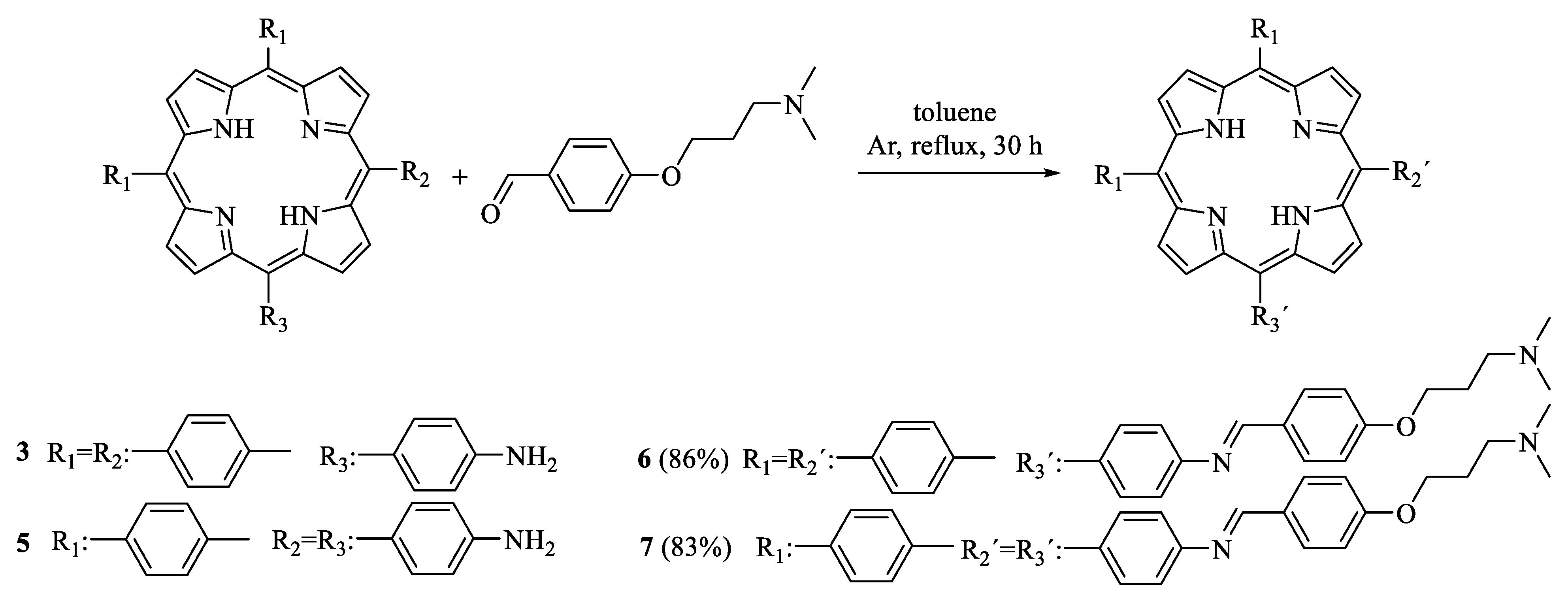
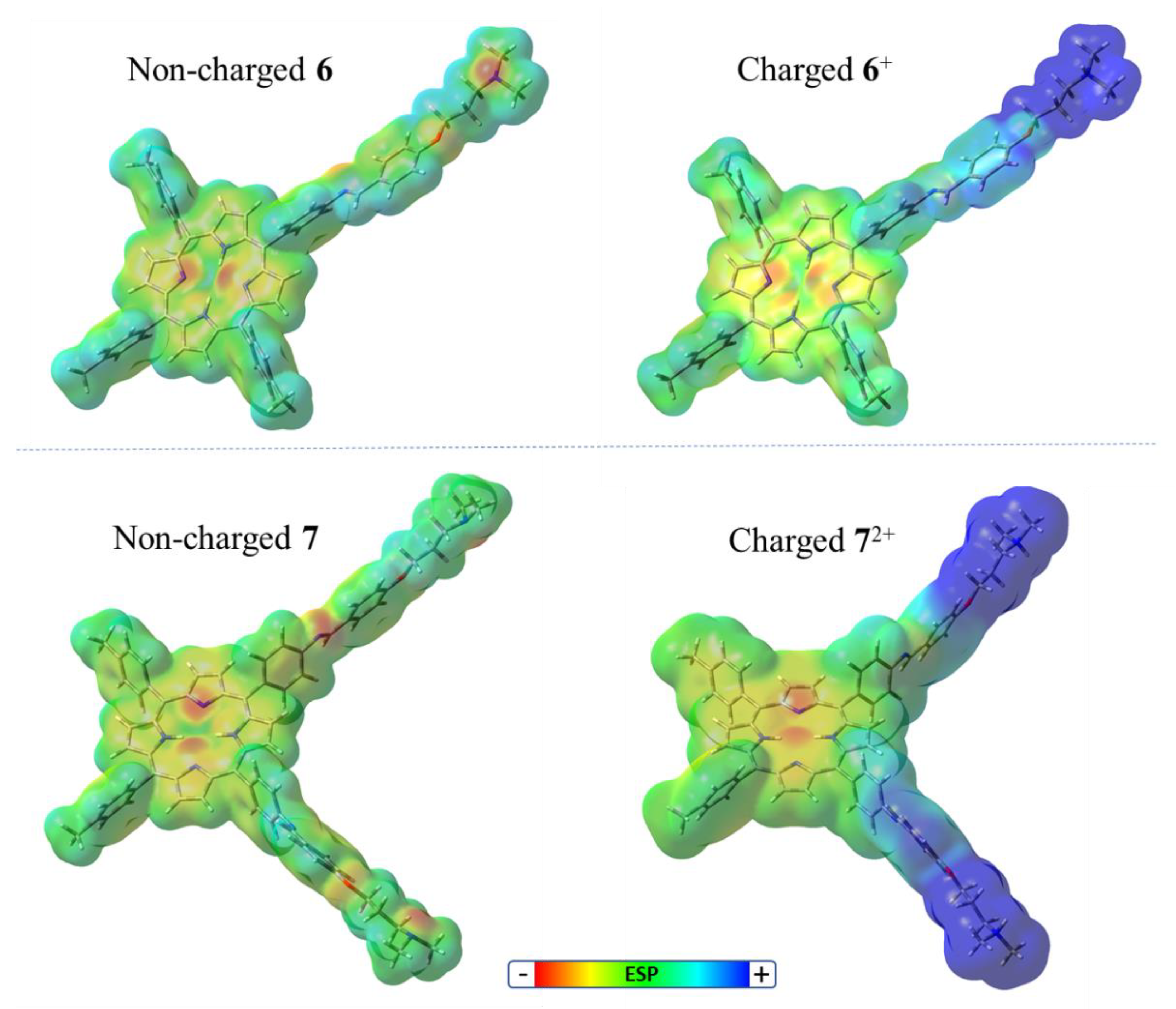

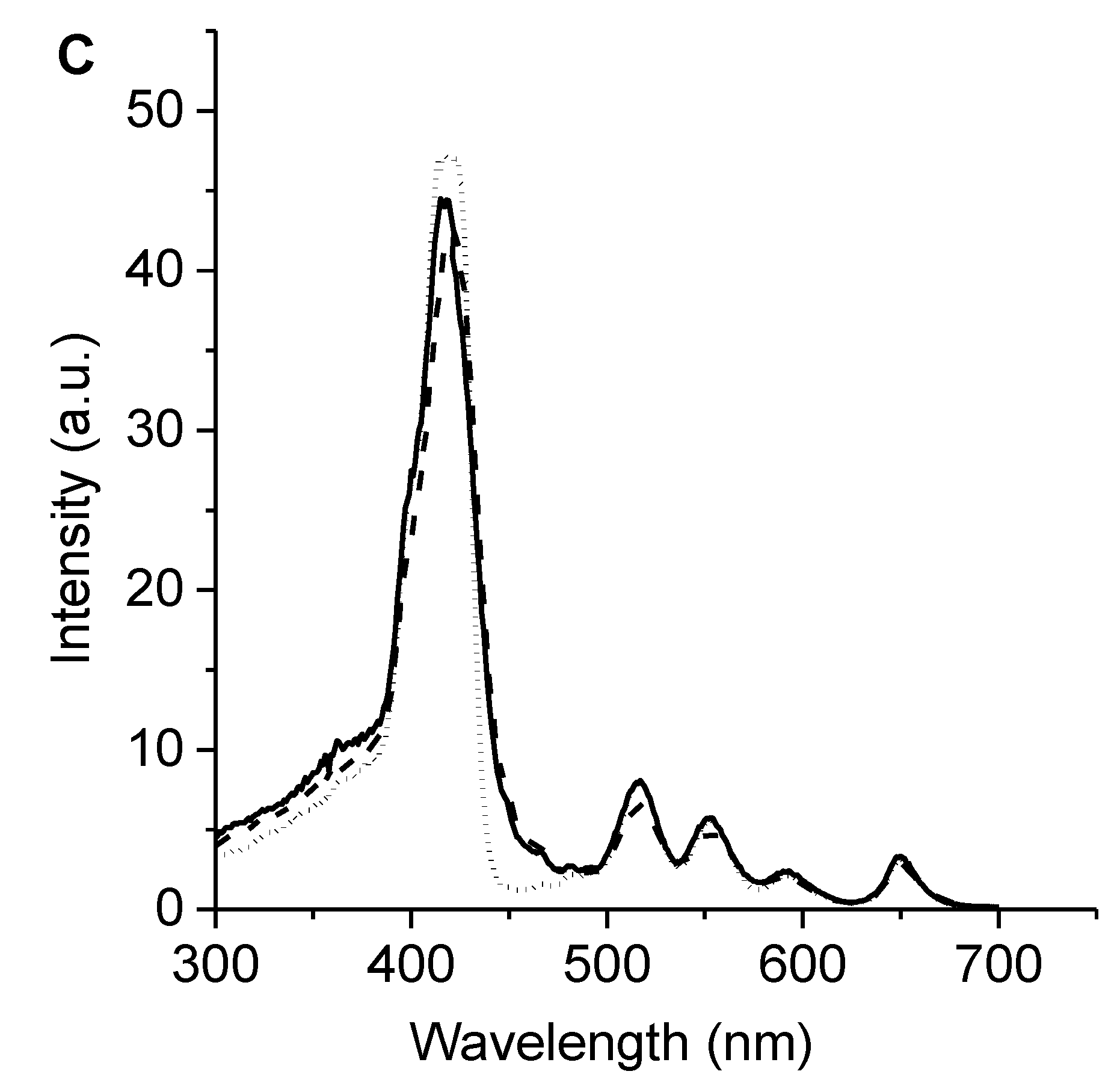
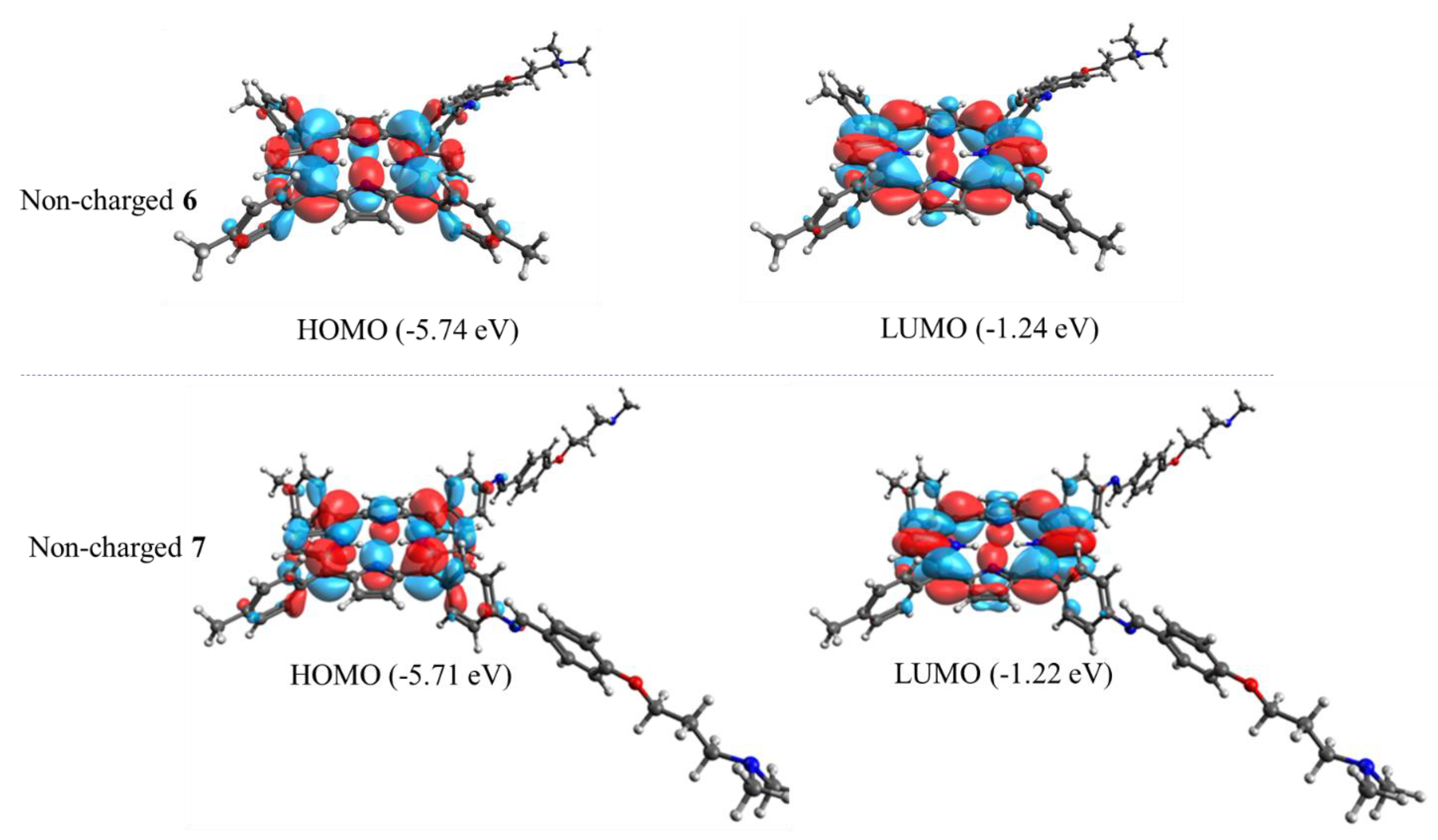
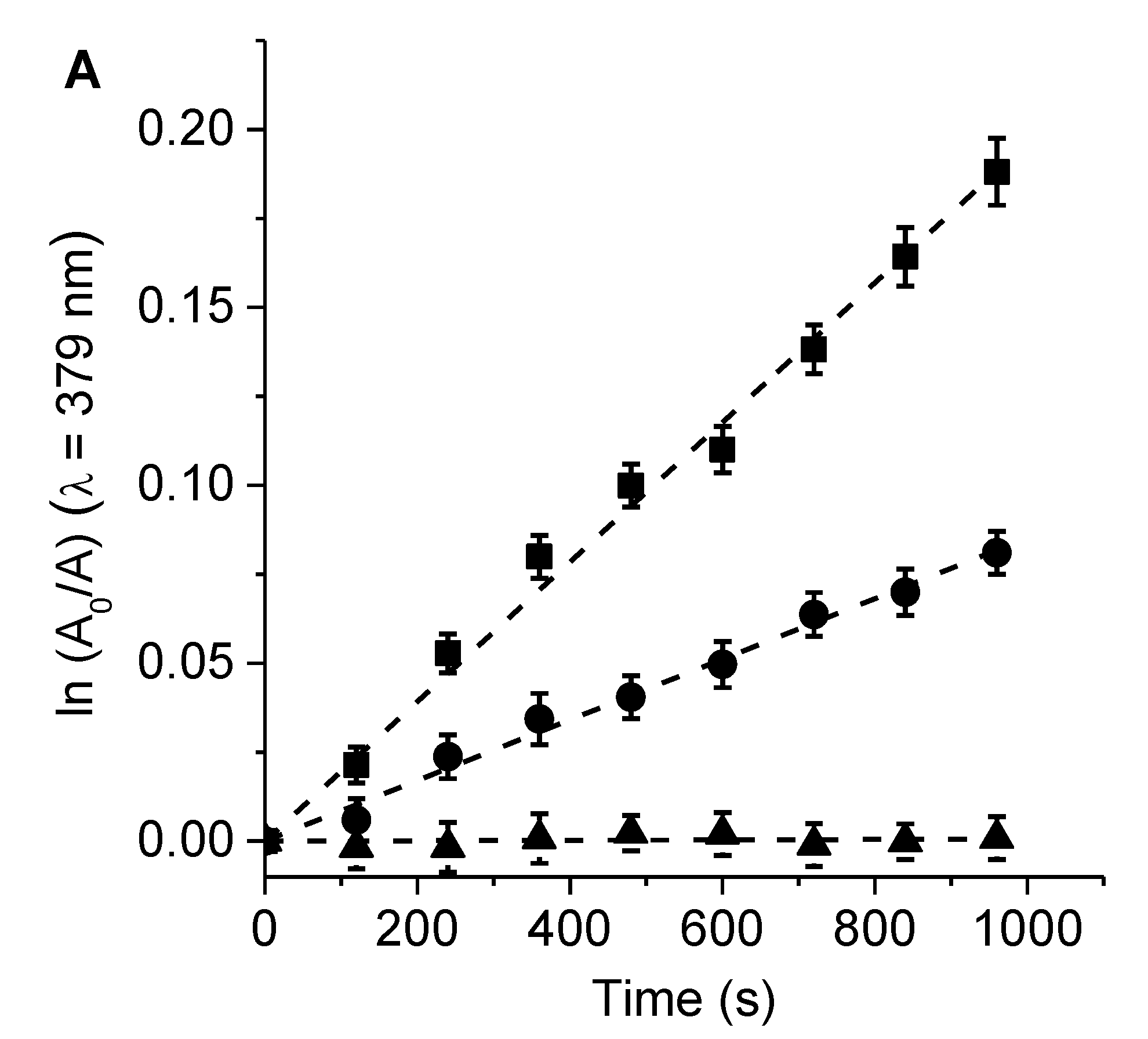
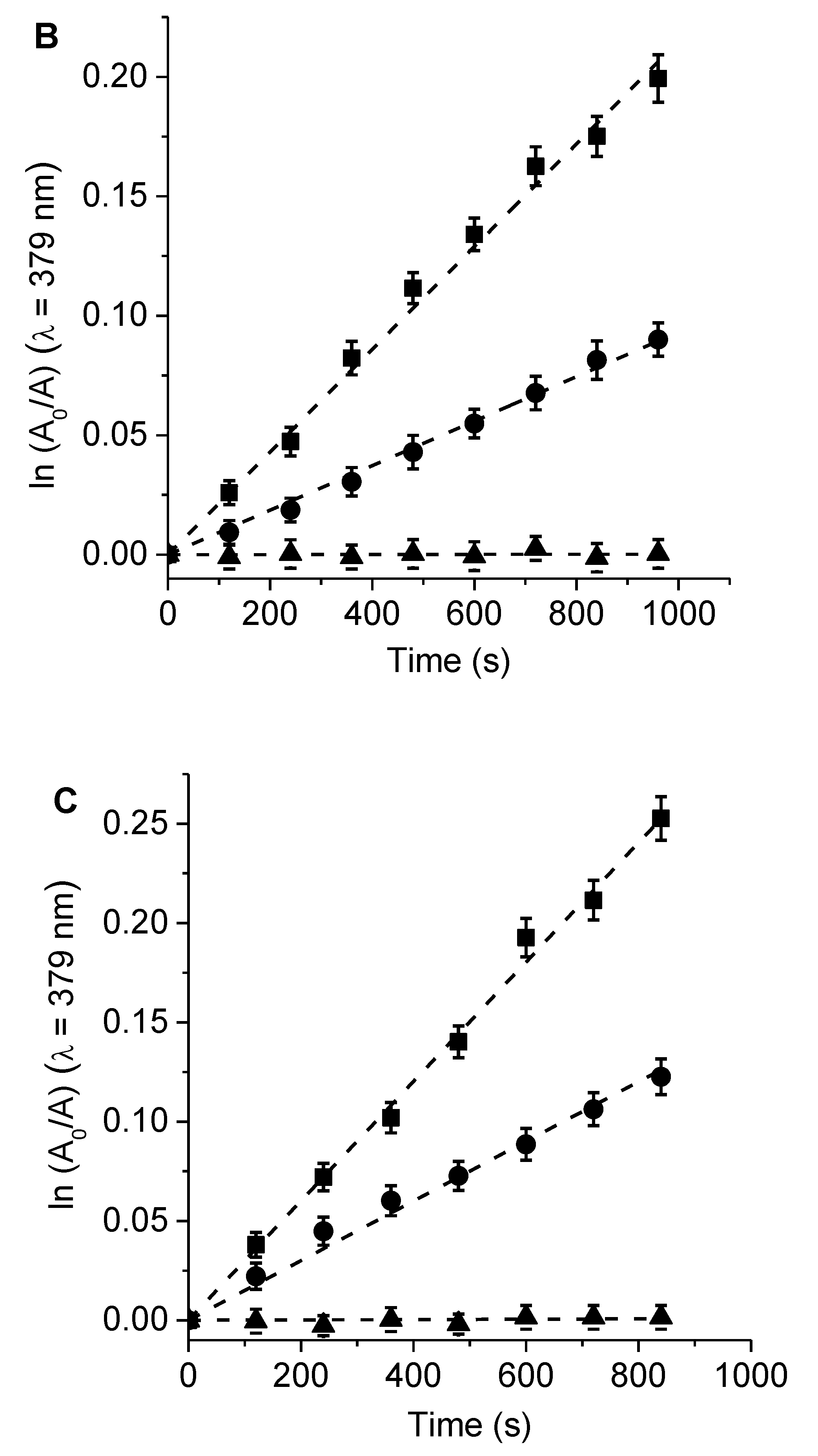

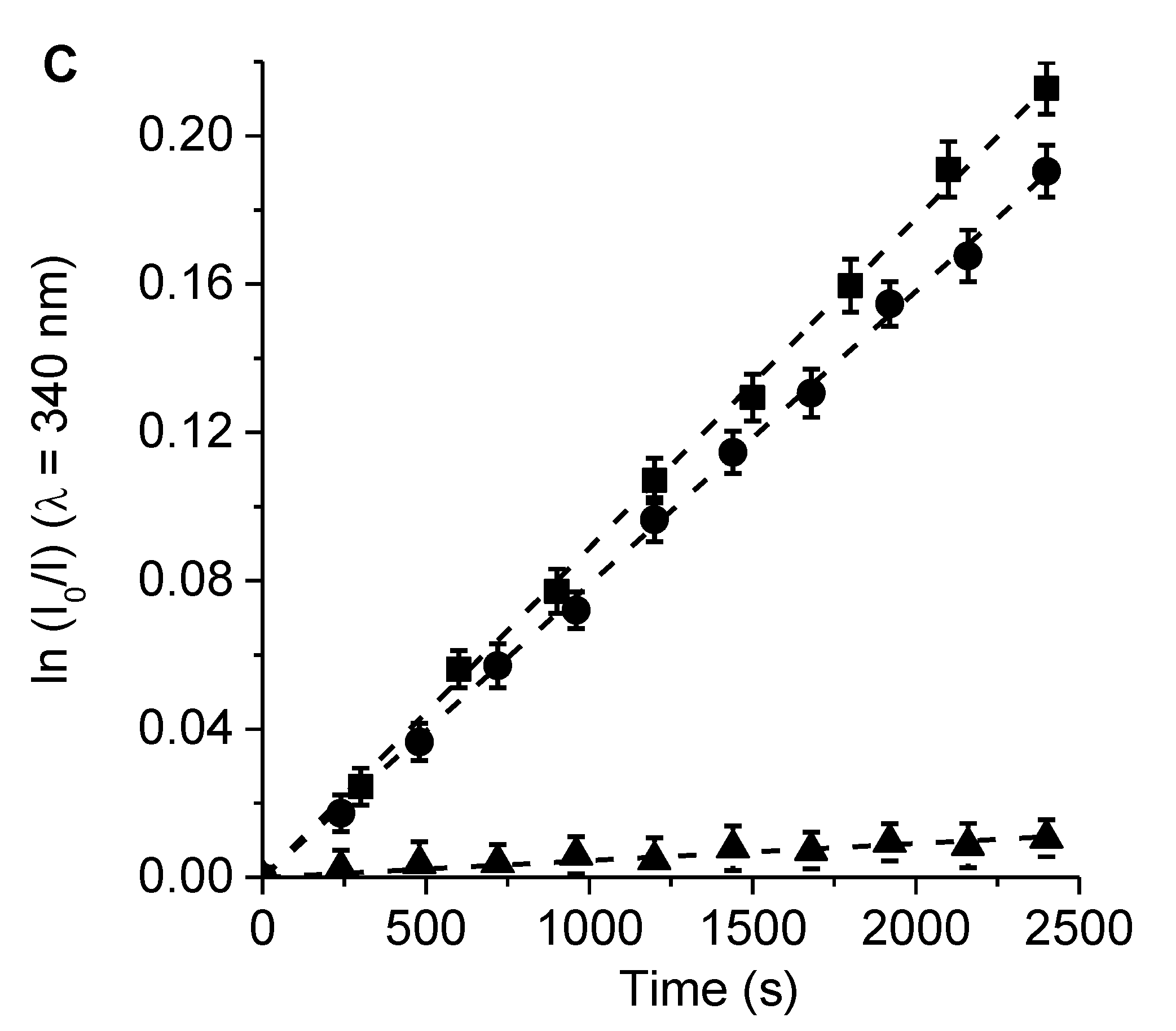

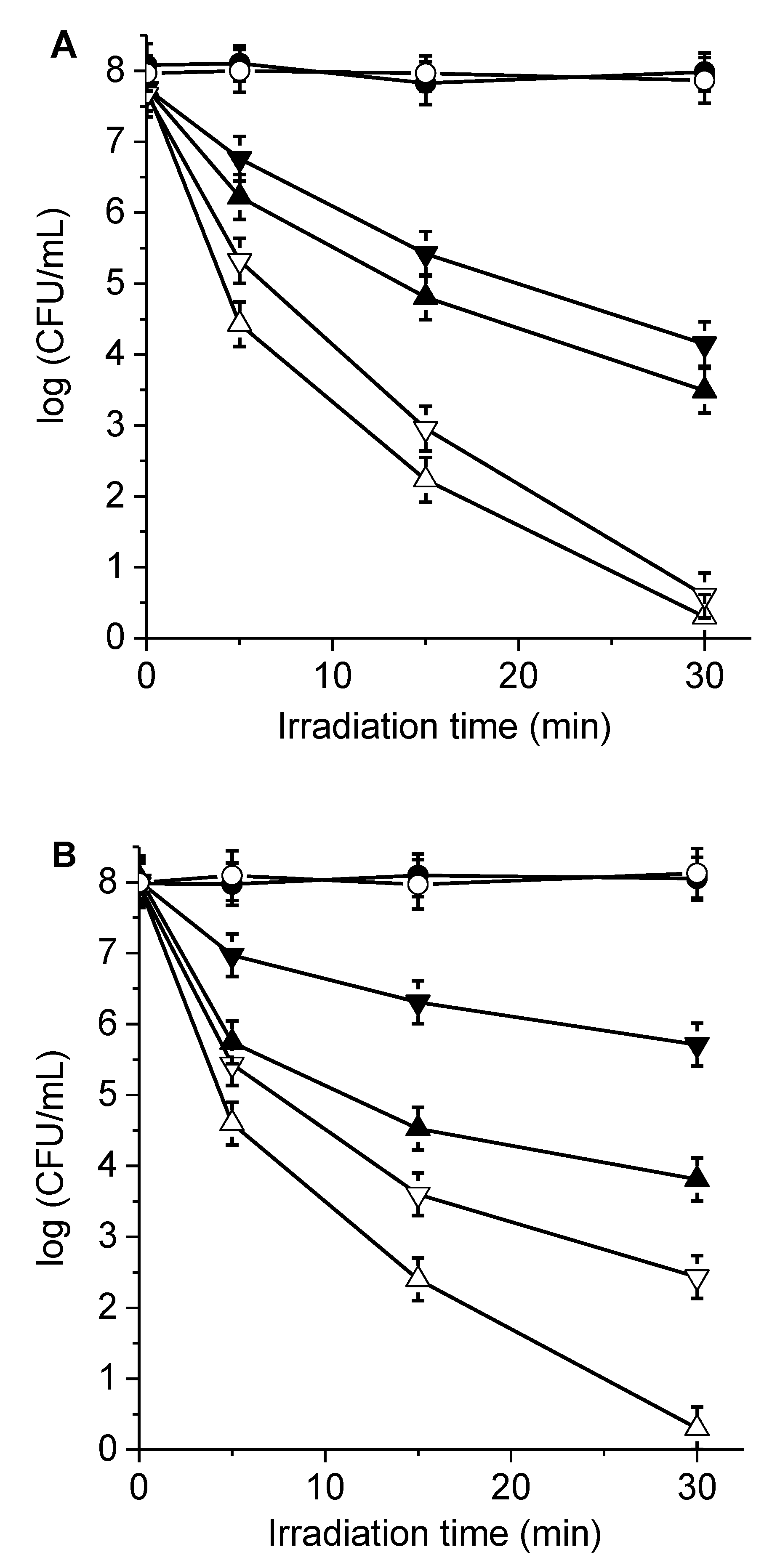
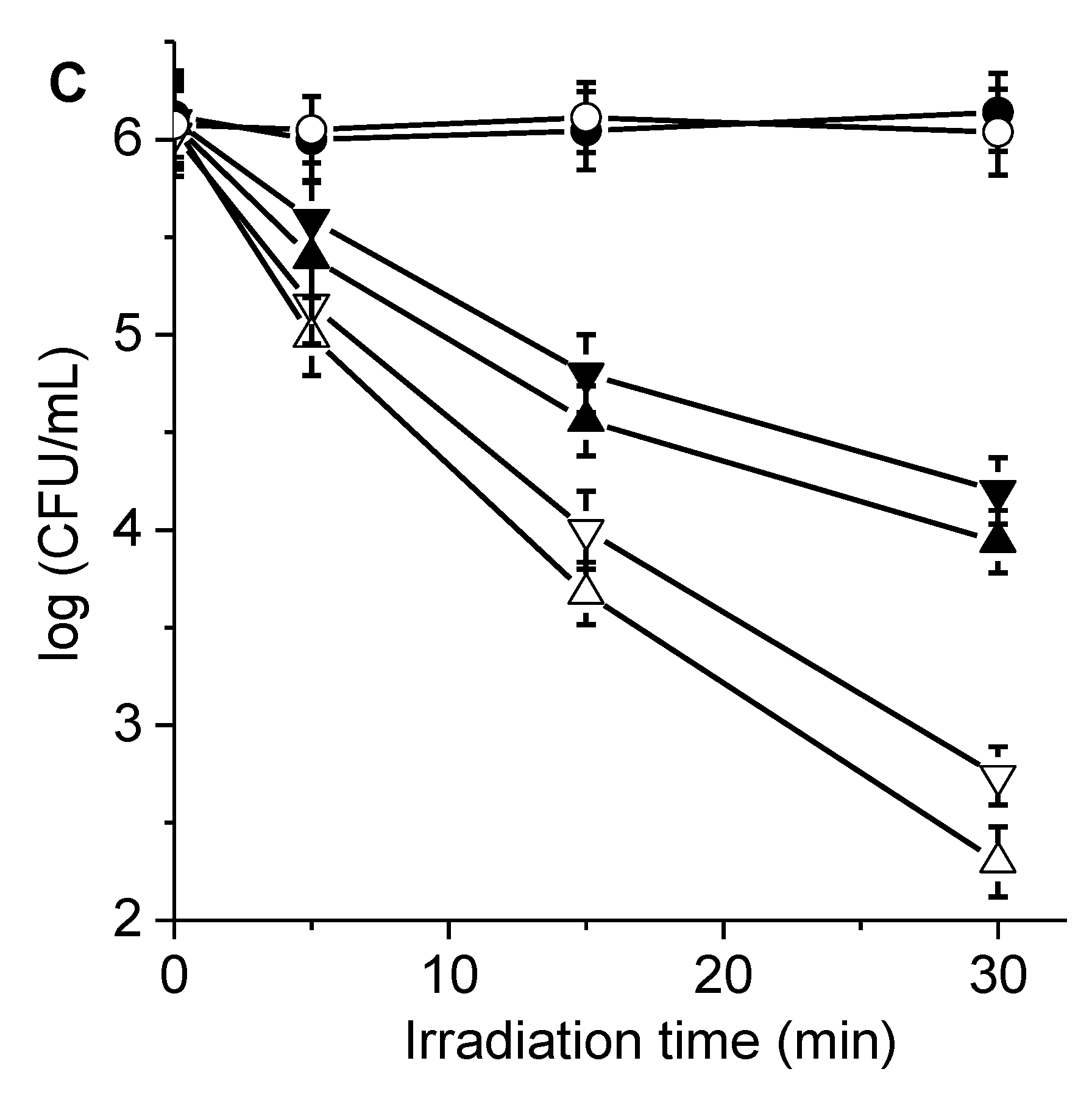
| Porphyrin | kobsDMA (s−1) a | kobsDMA (s−1) b | kobsDMA (s−1) c | ΦΔ a |
|---|---|---|---|---|
| 6 | (1.96 ± 0.05) × 10−4 | (0.85 ± 0.03) × 10−4 | ND | 0.42 ± 0.02 |
| 7 | (2.15 ± 0.06) × 10−4 | (0.93 ± 0.04) × 10−4 | ND | 0.46 ± 0.02 |
| TMP | (3.01 ± 0.08) × 10−4 | (1.50 ± 0.06) × 10−4 | ND | 0.65 ± 0.03 d |
| Porphyrin | kobsTrp (s−1) a | krTrp (M−1 s−1) | kobsTrp (s−1) b | kobsTrp (s−1) c |
|---|---|---|---|---|
| 6 | (3.66 ± 0.06) × 10−5 | (9.33 ± 0.09) × 106 | (5.12 ± 0.05) × 10−5 | (3.60 ± 0.08) × 10−6 |
| 7 | (5.08 ± 0.05) × 10−5 | (1.18 ± 0.01) × 107 | (6.90 ± 0.06) × 10−5 | (4.15 ± 0.09) × 10−6 |
| TMP | (8.88 ± 0.08) × 10−5 | (1.47 ± 0.01) × 107 | (7.89 ± 0.07) × 10−5 | (4.57 ± 0.08) × 10−6 |
Publisher’s Note: MDPI stays neutral with regard to jurisdictional claims in published maps and institutional affiliations. |
© 2021 by the authors. Licensee MDPI, Basel, Switzerland. This article is an open access article distributed under the terms and conditions of the Creative Commons Attribution (CC BY) license (https://creativecommons.org/licenses/by/4.0/).
Share and Cite
Pérez, M.E.; Durantini, J.E.; Reynoso, E.; Alvarez, M.G.; Milanesio, M.E.; Durantini, E.N. Porphyrin–Schiff Base Conjugates Bearing Basic Amino Groups as Antimicrobial Phototherapeutic Agents. Molecules 2021, 26, 5877. https://doi.org/10.3390/molecules26195877
Pérez ME, Durantini JE, Reynoso E, Alvarez MG, Milanesio ME, Durantini EN. Porphyrin–Schiff Base Conjugates Bearing Basic Amino Groups as Antimicrobial Phototherapeutic Agents. Molecules. 2021; 26(19):5877. https://doi.org/10.3390/molecules26195877
Chicago/Turabian StylePérez, María E., Javier E. Durantini, Eugenia Reynoso, María G. Alvarez, María E. Milanesio, and Edgardo N. Durantini. 2021. "Porphyrin–Schiff Base Conjugates Bearing Basic Amino Groups as Antimicrobial Phototherapeutic Agents" Molecules 26, no. 19: 5877. https://doi.org/10.3390/molecules26195877







